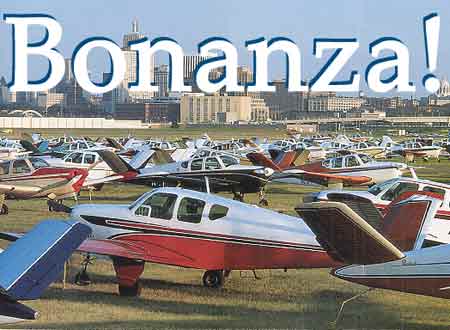
PAGE TWO
Model 35
The original Bonanza, the so-called Straight 35, featured
a steel tubing centersection which joined the wings together.
This structure has been known to develop cracks as well as
being a place where rust can begin, if the aircraft isn’t
properly stored. Many of the aircraft have been modified
with an aluminum web type beam carry through structures.
There is also an AD modification that fixes any problems
with the existing steel tube carry-through.
All of the early series Bonanzas, up through 1958, used the “E” series
Continental six-cylinder engines of variing horsepower with
the Straight 35 beginning life with 165 hp, but settling
on a 185 hp version of the engine. All of the “E” series
store their oil in a separate oil tank as part of a dry sump
system.
As originally equipped, the aircraft had wooden laminated
blades on an electrically controlled propellor. It wasn’t
a constant speed, but was a true “variable pitch” unit
that required the pilot to reset the rpm to match his power
requirements, but it wouldn’t change automatically.
Once the prop is set, acts like a fixed pitch unit. Many
of these kinds of propellers are still flying, but most have
had metal blades or a later series of prop installed.
 Beginning
with the very first airplane and continuing through most of its production
life, the Bonanza had a down-spring in the elevator system. This was installed
to keep a pilot from in advertently getting the airplane too slow on final.
The theory has been that, when flying at trim speed, the trim tab could overcome
the down spring, but, if the airplane slows below trim speed, the down spring
overpowers the trim tab and forces the nose back down. Most of the time the
pilot isn’t even aware it is there.
Beginning
with the very first airplane and continuing through most of its production
life, the Bonanza had a down-spring in the elevator system. This was installed
to keep a pilot from in advertently getting the airplane too slow on final.
The theory has been that, when flying at trim speed, the trim tab could overcome
the down spring, but, if the airplane slows below trim speed, the down spring
overpowers the trim tab and forces the nose back down. Most of the time the
pilot isn’t even aware it is there.
Incidentally, famed aerobatic pilot Bevo Howard did a full
aerobatic routine in the airplane at the 1948 Cleveland Air
Races which included a snap roll on the top of a loop. Reportedly,
while working up his act at the factory, he routinely performed
outside (!) loops from the bottom. This, obviously, is NOT
recommended in the POH.
The straight 35’s also didn’t have nosewheel steering,
relying instead, on differential braking. The 1949 A35 introduced
nosewheel steering and the B35 went to 196 hp.
| Model | Year | Prices | Speed, knots |
| 35 | 1947 | $29,000 | 150 |
| A35 | 1949 | $31,000 | 148 |
| B35 | 1950 | $34,000 | 148 |
C35-1951/1952
Besides getting a 205 hp E-185 engine, the C models also
mounted the first standard all-metal prop. The C35 also introduced
the first major increase in the tail size with the chord
becoming 20% wider and the tail angle, as measured from the
horizon, increasing from 30° to 35° in an effort
to combat the airplane’s tendency to “hunt” back
and forth. This became known as the Bonanza Boogie.
Bonanza wings changed continually through the airplane’s
life span, but the C35 introduced the first major beef up.
| Model | Year | Prices | Speed, knots |
| C35 | 1951 | $29,000 | 152 |
| D35 | 1953 | $31,000 | 152 |
| E35 | 1954 | $34,000 | 152 |
F35 - 1955
The triangular third window was added to the fuselage in
1955, giving a fairly consistant way to judge an airplane’s
age. At the same time the spar web was extended into the
centersection and the wings received markedly heavier leading
edge skins along with two ten gallon aux tanks in the wings.
Model Year Prices Speed, knots
F35 1955 $43,500 160
G35 - 1956
The “G” models were the very last to use the “E” series
engine and introduced yet more beefing up of the wings.
Model Year Prices Speed, knots
G35 1956 $46,250 160
 H35
- 1957
H35
- 1957
If there is such a thing as a “second generation” Bonanza,
the H35 would be it because the changes were deep and widespread.
Among other things, the “H” model is the first
Bonanza to get the new 0-470-G engine of 240 hp. This engine
was/is a “wet sump” engine, meaning that all of
the oil is kept within the engine with no separate oil resevoir.
Also, the engine was coupled to a true hydraulic, constant
speed propeller.
The wings got more than their share of attention in that
the spar caps were replaced with the beefy units from the
heavier Twin Bonanza as well as it’s heavier leading
edges.
The tail got heavier spar caps, as well and the elevators
were modified to include more spars.
| Model | Year | Prices | Speed, knots |
| H35 | 1957 | $52,000 | 165 - 240 hp |
| J35 | 1958 | $54,000 | 174 - 250 hp |
| K35 | 1959 | $57,000 | 170 - 250 hp |
| M35 | 1960 | $59,500 | 170 - 250 hp |